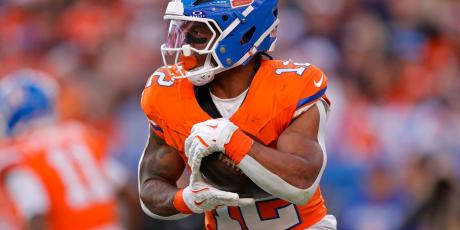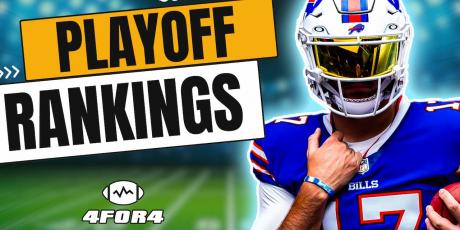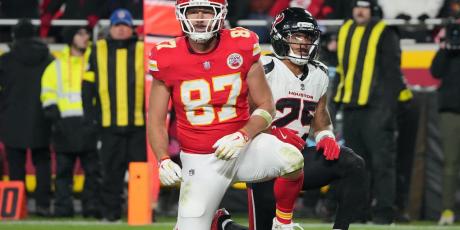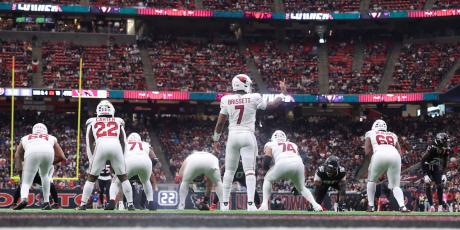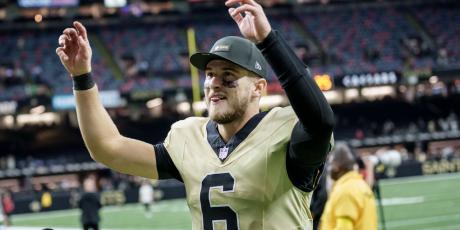Which Teams Invested in Defense in 2024?

Every offseason, once the main part of free agency is over, I compile all the defensive free agent signings to get a quantitative sense of which teams are investing on that side of the ball. One of the best measures of a player's value and ability is the contract that they sign, so I compile the Average Annual Value for each team's free agents in (players the team signed) and free agents out (players signed away by other teams) to come up with a net dollar value for each team.
A team with a large positive number means that they brought in significantly more salary (i.e. talent) than they lost and, if they spent wisely, the team should be better on that side of the ball. Conversely, a team with a large negative number means they lost significantly more talent than they brought in, and the team should be worse on defense. Caveat: Quality coaching, draft picks, and the development of younger players can offset losses in free agency.
To sum up, here are the five factors that I consider when evaluating a fantasy defense:
1. Previous year’s finish
2. Quality of coaching
3. Strength of schedule
4. Quality of offense
5. Personnel changes from the previous year
Examining defensive free agency spending (as well as high-capital draft picks) helps to quantify the fifth factor.
Last Season Overview
Last year, six teams spent a net of $15.0 million or more on defense and those teams averaged a 23% increase in year-over-year fantasy scoring. Those teams allowed 8% fewer (real-world) points as well.
The top five spenders–Falcons (+35%), Bears (+54%), Browns (+24%), Seahawks (+7%), and Texans (+24%)–averaged 29% more fantasy points per game than the year before. They also allowed 8% fewer real-world points in 2023.
Historical Trends in Defensive Spending
Since I started tracking this data in 2016, the 68 teams that have invested a net of at least $7.0 million on defense in a given year enjoyed an average increase in fantasy scoring of 20%. Forty-three of the 68 teams improved, while the other 25 teams had no change or a negative change in fantasy scoring. Again, results are a mixed bag, but the positive trends are there.
Teams that invested less than a net of $7 million or had a net decrease in defensive payroll saw a 2% decrease in fantasy scoring. (For those wondering, teams that invested $0 to $7 million saw a 4% increase in fantasy scoring, on average.)
On the flip side, the 94 teams that saw a net decrease of at least $4 million on the defensive side of the ball saw their fantasy production decline 6% on average.
Ultimately, defensive spending in free agency is not a magic bullet for evaluating fantasy defenses, but it is another valuable data point that can indicate defensive units poised for an increase (or decrease) in production.
2024 Defensive Spending
Below is a table of the 2024 net free agency investment by each team. I also included the number of draft picks used in the first three rounds on defensive players to see which teams were using significant draft capital to shore up that side of the ball.
Note: Since there were several significant trades, I’ll add trade movement to this data starting this season.
| Team | Net # In | Net $ In | Rank | Drafted In First Three Rounds | Net Players In |
|---|---|---|---|---|---|
| DET | 1 | $24,542,500 | 1 | 2 | 3 |
| ARI | 5 | $22,468,333 | 2 | 3 | 8 |
| WAS | 0 | $21,081,000 | 3 | 2 | 2 |
| PIT | -2 | $19,258,167 | 4 | 1 | -1 |
| LV | 3 | $13,125,000 | 5 | - | 3 |
| DEN | 1 | $12,296,667 | 6 | 1 | 2 |
| LAR | -3 | $11,500,000 | 7 | 3 | 0 |
| TEN | 4 | $9,557,500 | 8 | 1 | 5 |
| HOU | -2 | $9,277,500 | 9 | 2 | 0 |
| NYJ | -2 | $7,762,500 | 10 | - | -2 |
| NO | -1 | $7,307,500 | 11 | 1 | 0 |
| GB | 1 | $7,125,000 | 12 | 3 | 4 |
| SEA | 1 | $6,900,000 | 13 | 1 | 2 |
| NYG | -1 | $6,620,000 | 14 | 2 | 1 |
| IND | 0 | $4,582,500 | 15 | 1 | 1 |
| JAC | 0 | $4,540,000 | 16 | 2 | 2 |
| CLE | 2 | $2,432,500 | 17 | 1 | 3 |
| CHI | 0 | $779,167 | 18 | - | 0 |
| NE | 0 | $365,000 | 19 | - | 0 |
| LAC | 0 | -$777,500 | 20 | 1 | 1 |
| CIN | 0 | -$3,832,500 | 21 | 2 | 2 |
| ATL | 2 | -$5,220,000 | 22 | 2 | 4 |
| PHI | -1 | -$6,915,000 | 23 | 3 | 2 |
| SF | -1 | -$11,015,000 | 24 | 1 | 0 |
| BUF | 0 | -$15,310,000 | 25 | 2 | 2 |
| CAR | -1 | -$15,390,000 | 26 | 1 | 0 |
| MIN | -4 | -$15,447,500 | 27 | 1 | -3 |
| DAL | 0 | -$16,382,500 | 28 | 2 | 2 |
| TB | 4 | -$16,500,000 | 29 | 2 | 6 |
| MIA | -3 | -$24,676,667 | 30 | 1 | -2 |
| KC | -4 | -$24,900,000 | 31 | - | -4 |
| BAL | 0 | -$35,154,167 | 32 | 2 | 2 |
A Few Takeaways
I’ll provide some team-by-team context below. I’ll include the collective Average Annual Value for the team’s free agent crop along with notable individual players and their positional PFF rankings, if applicable.
Note: DI (defensive interior), ED (edge), LB (linebacker), S (safety), CB (cornerback)
-
The Lions (+24.5 million) lead the way in offseason net spending, largely due to the trade for cornerback Carlton Davis (CB92, $14.5 million). They also added defensive tackle D.J. Reader (DI12, $11.0 million), and defensive end Marcus Davenport ($6.5 million), who was injured most of 2023. In the draft, the Lions added cornerbacks Terrion Arnold in the first round and Ennis Rakestraw in the second round, so it was clear that pass defense was an offseason focus. The Lions were the No. 26 fantasy defense last season, but with all these new faces, they could become a good streaming option.
-
The Cardinals (+$22.5 million) finished as the No. 31 fantasy defense last year, so there’s almost nowhere to go but up. They signed defensive tackle Justin Jones (DI115, $10.4 million), cornerback Sean Murphy-Bunting (CB96, $8.5 million), and defensive end Bilal Nichols (DI100, $7.0 million), then added defensive end Darius Robinson in the first round, cornerback Max Melton in the second round, and cornerback Elijah Jones in the third round. Given their starting point, it’s unlikely that the Cardinals defense becomes an every-week fantasy starter, but if things come together, Arizona could be in the streaming conversation. Nick Rallis is in his second season as the defensive coordinator.
-
The Commanders (+$21.1 million) finished one spot ahead of the Cardinals (No. 30), so defense was a priority again this offseason. They added defensive end Dorance Armstrong (ED51, $11.0 million), linebacker Bobby Wagner (LB7, $6.5 million), safety Jeremy Chinn (S81, $4.1 million), defensive ends Clelin Ferrell (ED87, $3.8 million) and Dante Fowler (ED71, $3.3 million), among others. They also added defensive tackle Jer’Zahn Newton and cornerback Mike Sainristil in the second round. The Commanders’ net seven players is the second most after the Cardinals (8), so first-year defensive coordinator Joe Whitt Jr. has his work cut out for him. Washington has the easiest schedule per my SOS calculations, so the Commanders could turn into a good streaming option if the personnel gels quickly.
-
The Steelers (+$19.3 million) finished as the No. 12 fantasy defense last season and added linebacker Patrick Queen (LB25, $13.7 million) and safety Deshon Elliott (S25, $3.0 million) in free agency before taking linebacker Payton Wilson in the third round of the draft. They also added CB Donte Jackson (CB71, $6.0 million) via trade. Per my SOS calculations, they have the eighth easiest schedule as well. The Steelers looked poised for another top-12 finish.
-
The Raiders (+$13.1 million) surprisingly finished as the No. 6 fantasy defense in 2023. They added the top-priced defensive free agent–defensive tackle Christian Wilkins (DI24, $27.5 million) which offset the loss of Bilal Nichols, Amik Robinson, and Jerry Tillery in free agency. The Raiders did not draft a defensive player in the first three rounds, though they did take four defensive players in rounds 4-7.
-
After finishing as the No. 10 fantasy defense last season, Houston (+$9.3 million) added outside linebacker Danielle Hunter (ED33, $24.5 million), though they lost Jonathan Greenard (ED32, $19.0 million) via free agency and Maliek Collins (DI54, $11.5 million) via trade. They also added defensive end Denico Autry (ED83, $10.0 million), defensive tackle Tim Settle (DI81, $3.0 million), defensive end Foley Fatukasi ($5.1 million), and cornerback Jeff Okudah (CB121, $4.8 million), among others. They drafted cornerback Kamari Lassiter and safety Calen Bullock in the second and third rounds, respectively, so they also added talent in the draft. Head coach DeMeco Ryans and defensive coordinator Matt Burke are both returning, so the defense has continuity. The only issue I see is a relatively tough schedule, No. 28 per my SOS calculations.
-
The Jets (+$7.8 million) were the No. 7 fantasy defense last season and should benefit from much better play by the offense this season. Their big defensive addition came via trade–outside linebacker Haason Reddick (ED35, $15.0 million)–though they also added defensive tackle Javon Kinlaw (DI112, $7.3 million).
-
Keep an eye on the Packers (+$7.1 million), who finished as the No. 24 fantasy defense but hired a new defensive coordinator and upgraded their safety position by signing Xavier McKinney (S4, $16.8 million). They also added three impact defensive players, linebackers Edgerrin Cooper and Ty’Ron Hopper, and safety Javon Bullard in the first three rounds.
-
The Ravens finished as the No. 1 fantasy defense, but they lost $35.2 million in salary, which is the most since I started tracking this data. The five teams that lost more than $30 million in salary saw an average decline of 27% in fantasy points. The Ravens lost Patrick Queen, Jadeveon Clowney, Geno Stone, and Ronald Darby but did add cornerback Nate Wiggins in the first round and defensive end Adisa Isaac in the third round. The Ravens have the ninth-easiest schedule per my SOS calculations, and they tend to draft well, so they should be able to reload.
-
The Chiefs (-$24.9 million) typically have a good fantasy defense but they weren’t great last season (No. 20 in per-game scoring) and they traded away L’Jarius Sneed (CB36, $19.1 million).
-
The Dolphins (-$24.7 million) may have trouble repeating their top-five finish from last season. They lost the top defensive free agent Christian Wilkins, Brandon Jones, Raekwon Davis, and Jerome Baker. They did add cornerback Kendall Fuller (CB5, $7.5 million) and linebacker Shaquil Barrett (ED34, $7.0 million) to slow the bleeding. They also added impact defensive end Chop Robinson in the first round.
-
The Cowboys (-$16.4 million) were last year’s No. 2 fantasy defense. They lost defensive end Dorance Armstrong, but drafted defensive end Marshawn Kneeland in the second round and linebacker Marist Liufau in the third round. Dallas has the fifth-easiest schedule, so I think they’ll be a good fantasy option again this year.
-
The 49ers (-$11.0 million) finished No. 8 last season and lost quite a bit of salary in free agency–Arik Armstead, Chase Young, and Javon Kinlaw, to name a few–though they managed to add defensive tackle Maliek Collins (DI54, $11.5 million), linebacker Leonard Floyd (ED97, $10.0 million) and defensive end Yetur Gross-Matos (ED66, $9.0 million). They also added cornerback Renardo Green in the second round of the draft. The 49ers have the No. 26 schedule so they could find themselves in the middle of the pack, fantasy-wise.








